You know the basics of keyword research and why it's essential, but your website isn’t like everyone else’s.
You need more than a basic keyword list to move the needle on your SEO and get traffic. So, you’re looking for some direction to go deeper and find some gems to build your plan around.
In this guide, we’re taking you beyond the basics and into some advanced tactics with the Keyword Magic Tool. Take our (virtual) hand as we help you discover how to find profitable keywords for organic traffic.
Advanced Keyword Research Strategies You Can Do Today
First, let’s touch on the basics. We’ll assume you know how to simply check any keyword in Semrush using a Keyword Overview, filter lists for low competition keywords, and build a master list with the Keyword Strategy Builder.
If not, go for a refresher by reading How to Use Semrush for Keyword Research.
Advanced tactics are what can take your SEO plan above and beyond any of your competitors that are just doing the SEO minimum.
Here’s what you can do today after reading this post:
- Find the most profitable keywords for your niche
- Research targets for Barnacle SEO
- Find keywords with the right intent
- Discover featured snippets you can target
- Use image SEO to your advantage
- Answer the search query better than your competitors
- Combine Google Search Console and Keyword Magic Tool to find new ideas
These techniques, combined with Keyword Magic Tool, can help you have the best chance at ranking for the first position on search engines for your targeted keywords.
What is the Keyword Magic Tool?
Keyword Magic Tool is a tool that lets you easily create a master keyword list that’ll help you bring traffic to your website. Entering just one seed keyword will be enough for you to build a whole keyword roadmap around it.
With this keyword research tool, you’ll be able to find valuable search queries across the globe. As of May 2022, it supports 142 databases with billions of keywords in total, and our keyword database keeps expanding at a very fast pace.
Is the Keyword Magic Tool Free?
Yes, the Keyword Magic Tool is free and easy to use. Use this free tool to get 10 keyword reports/pages from just one seed keyword. To see even more keywords to help boost your online visibility, you can always try a free 7-day trial.
Finding the Right Keywords for Your Niche
Just because a keyword has a high search volume doesn’t necessarily mean it’s right for your website. What matters more is finding search terms that resonate with your audience, and the topics with it.
Getting “advanced” in your keyword research for your niche involves getting a little creative. Think like your target audience. What sites and forums would they visit when they have a question?
You can visit forums to brainstorm keyword ideas that your competition hasn’t found yet.
Let’s think of Reddit, for example. Is there a recent question in a subreddit that pertains to your niche with a decent amount of upvotes? You can snag that question as a long-tail keyword so the next time, your target audience navigates to your site instead of Reddit.
Pop that into the Keyword Magic Tool and you’ll have a massive list of keyword ideas to elevate your content marketing strategy.
Take a look at this question from the subreddit, I Want to Learn (/r/IWantToLearn):

Is this a viable search term for your site? You can easily find out with the Keyword Magic Tool:

Not only does this look like a possible term you could rank for, but it also looks like there are a variety of other keywords that you could use in the same blog post. Jesse McDonald, Global SEO Strategist at IBM, told us that this allows him to build his roadmap.
Every time I begin keyword research for a site, I start with the Keyword Magic Tool…This will allow you to build a roadmap around the topics to show where things should sit within the silo and how to best link to each content piece. You can also use this information to understand the more specific terms to expand upon within a specific piece of content within the silo.
How to Answer the Search Query Better Than Your Competitors
Google wants to give people the best answers to their search queries. If you have the most helpful and thorough answer, Google is likely to give your content the chance to shine.
But what exactly does that mean and how can Semrush help? We break it down into three steps:
- Fill in the gaps
- Focus on one topic at a time
- Make your content more in-depth than your competitors
Fill in the Gaps
Especially take some time to notice the top results for your keywords and find pieces of information they leave out.
Maybe you’re writing about the best dog breeds for families with young children. Your competitors provide that information, but they don’t have any scientific studies to back it up.
If your piece lists the kid-friendly dog breeds plus factual evidence to back it up, you’re looking at that top position.
The more relevant information you can add to the topic you’re focusing on, the more likely Google will approve.
Also, filling in the gaps includes providing new information. Google favors good, recent content. Use up-to-date information, especially if you see the first results for your targeted keyword belong to an article that is over a year old.
Focus on One Topic at a Time
You know about the dangers of keyword stuffing but what about trying to focus on too many keywords? Focusing on too many topics can muddle the point of your article and confuse your readers and Google.
To combat this common pitfall, you should break down your topic into smaller subtopics as much as possible and focus fully on each topic one at a time.
For instance, your website is a place to find dog training tips. With a little time digging in the Keyword Magic Tool, you could discover subtopics for your site like:
- Becoming a dog trainer
- Classes for dogs
- Puppy training tips at home
- Advanced dog training
While these are all related, you wouldn’t want to write about how to become a dog trainer, classes for dogs, and puppy training tips at home all in the same blog post. It’s a good idea to keep this in mind as you take your keyword research into your content strategy—one article, one topic at a time.
To use the Keyword Magic Tool to find related search terms for your articles, click on the Related tab to find keywords related to your seed search.

Results here might not contain the exact phrase but will be semantically related. Check the Related % metric to see results that relate the most to your seed keyword (100 signals it’s the most related and 0 is the least).
From there, you can click on the different reports to access thousands of terms that you can weave throughout your article with a free trial. Those with a free account will still be able to find a solid amount of winning keywords.
For those with a paid account or free trial, there’s another way you could organize lists of topically-relevant keywords together.
With a few clicks, you can use Keyword Strategy Builder to quickly find related keywords for a concept you’re covering so you can target a topic to the fullest. Check out the blog to see how.
Make Your Content More In-Depth Than Your Competitors
Before anything, we need to start by saying putting more words on a page than your competitors’ content won’t help you rise on SERPs. However, creating longer content that adds value can help.
Think about the first part of this section: figure out what information you can add that your competitors don’t have. This can be an essential question that they don’t cover at all or more examples. But remember, don’t just add more semi-related subtopics into one article. Keep it one on topic, just go deeper.
Let’s say your competitor has an article on the best books for dog training that lists 20 books. Creating a list with 50 books, broken down by category gives readers more options to look through and provides a more thorough answer to the search query.
Using Keywords in Your Image Alt Text
Images optimized for search engines can also help you take up real estate in the images section on Google. And more people clicking through to your article (via image or article) is another signal to Google that your site is worth checking out! So, don’t skip this step.
Name Your Image File
If you don’t want Google to randomly choose a picture to go with your featured snippet, make sure your images are optimized (this means adding an alt description to them, and giving a human-readable name, like dog.jpg instead of hgfjhff.jpg).
Otherwise, Google may add a picture of its choice, even if it’s not from your site:

Use Keywords that Match the Image
Image SEO is an often ignored step in the keyword research process. But there’s no reason why you shouldn’t optimize other elements of your page, not just the text.
Use the keywords you’ve found or use search queries that are related to your primary keyword. What you shouldn’t do is force all of your primary keywords into the alt text (aka another form of keyword stuffing).
Alt Text Helps Visually Impaired People
As of 2021, at least 2.2 billion people are visually impaired, according to the World Health Organization. Image SEO helps people understand broken images, but also those who use screen readers.
Optimizing your images for web crawlers is important, but not as much as it is to write alt text that helps people use your website. Use keywords in your alt text where it fits and sounds natural, otherwise just stick to a normal description of what’s in the photo.
Finding Keywords with the Right Intent
Finding your target audience when they are ready to purchase is a good mindset to have when looking for keywords to bring conversions to your site. If you’re building up your brand, it’s not a bad idea to look for search queries that have transactional or commercial intent.
Of course, if you’re trying to reach searchers in the top stages of the funnel, search terms with informational intent are good to go after too.
What you don’t want to do is target keywords that are navigational and don’t belong to your brand.
Discover the search intent behind the terms on your master keyword list with the Intent filter within Keyword Magic Tool in an instant.

Keyword Research for Featured Snippets
Featured Snippets can help your business earn more visibility on Google, but they won’t appear on every single keyword’s SERP. Let’s talk about how to go about finding those keywords you can target to get more visibility.
The Keyword Magic Tool has a filter specifically for finding keywords with Featured Snippets, as shown below:

Use this filter to hone in on keywords that you can start targeting to get Featured Snippet placements, and more visibility and traffic.
There are several types of text that can result in a featured snippet: lists (ordered and unordered), pieces of text (usually in the form of an answer), headings, bullet points, and tables.
Based on that, we can think of at least three ways to get featured with our dog tail story.
Lists
Featured Snippets often come as lists, easy to skim and digest.
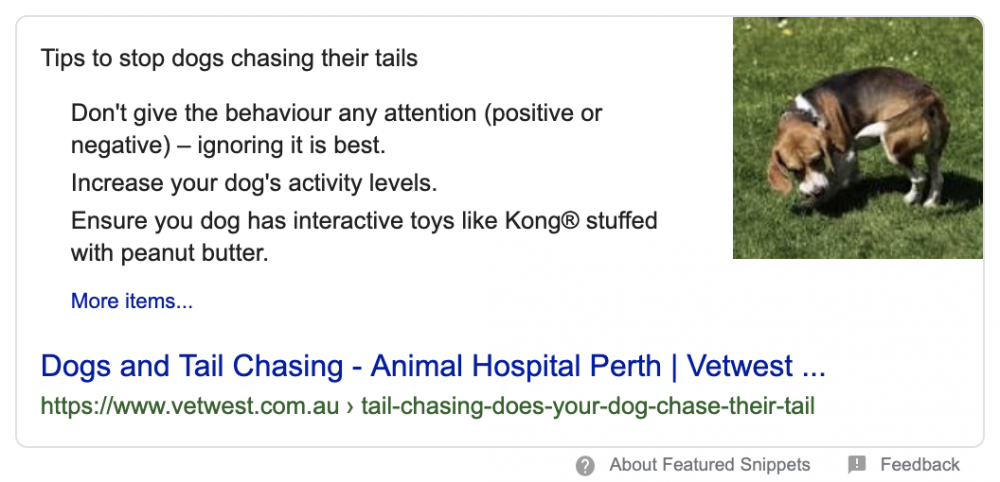
Without including any ordered or unordered lists in your content, you’ll be missing out on any potential list snippets at the top of Google.
Headings
If you want Google to pull together a list based on your headings, make sure they’re super logical. Let’s say you want to come up in the search for the question: What is my dog saying with his tail?
Here is an example of what your headings should look like:
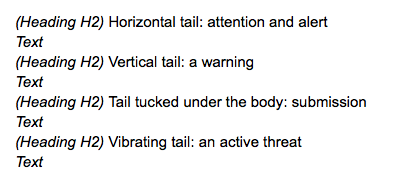
Remember that your headings won’t be treated as such if you don’t back them up with text. A heading always implies there should be at least one sentence following to explain it in more detail.
Questions and Answers
This is when you provide an answer to a question that’s bothering a lot of people right in the first paragraph of your blog post. Sometimes Google will pull together an answer from different parts of your text.
So if you don’t want to bother with lists (which is understandable), go with a question-answer paragraph. We’ll guide you through this using the Semrush Keyword Magic Tool.
Find the Queried Questions with the Most Search Traffic
Let’s say you want to get featured for the answer to: Why do dogs chase their tails? This, however, may not be the exact wording that people are searching for: they might omit “do” or use the possessive pronoun “my”.
To find that out, go to Keyword Magic, enter your seed keywords—dog, tail, and chase—and click the “Questions” button to get keywords in the form of a question
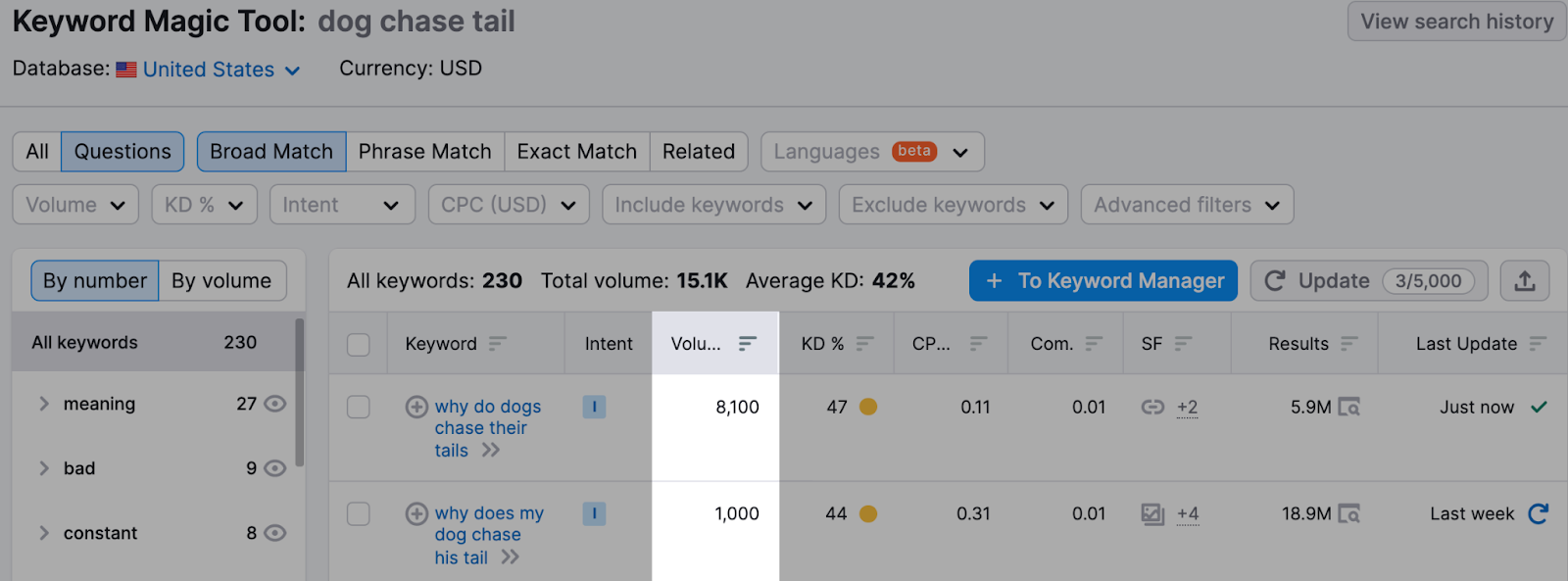
As you can see, the most popular question of dog owners is “why do dogs chase their tails,” and its volume is 8,100.
However, you shouldn’t judge a keyword just by its volume.
After volume, check how tough the competition is going to be (KD% for SEO competition), and take it from there. If you’re just starting out, place your bet on finding low competition keywords.
Analyze the Featured Snippets They Trigger
These snippets will be the key to your success. In the Keyword Magic Tool, click on the number of Results in SERP to see the snapshot of the featured snippet:

From here you can find out:
- Who got into the featured snippet
- What their exact question and answer were
- Which keywords they used
- How long their answer was
Here is an example:

As a result of quick keyword analysis, we discovered that:
- My competitor is not Wikipedia. Hence they are beatable.
- Their exact question was: Why Do Dogs Chase Their Tails?
- The keywords they used were tail, chase, dogs, compulsive behavior, chew, and treat.
- Their answer was 35 words long, so we’re also going to aim for that.
Use data like this when composing your answer.
Consider this section of Google too—it should give you a good idea of how people tend to formulate their questions:
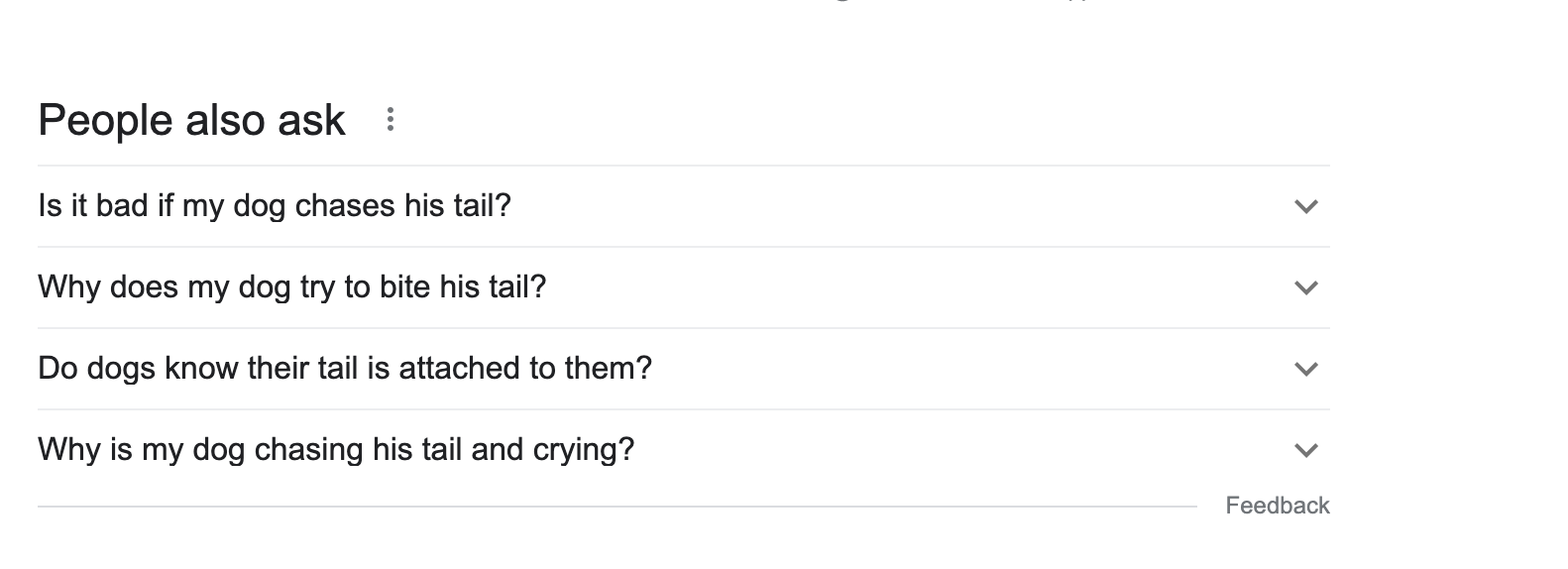
Before you make your final decision on which keywords to use in your, hopefully, soon-to-be featured snippet (who said the law of attraction doesn’t work), dig deep into Keyword Strategy Builder and get the most up-to-date info on your keywords’ difficulty and competitors.
Your perfect scenario is high-volume, long-tail, low competition keywords. If you discover that your competitors are hard to compete with, switch to longer keyword combinations with average volume.
Barnacle SEO Keyword Research
Keyword research isn’t just for your website. Creating content for reputable websites, like YouTube and Medium, can also bring traffic to your page via established sites like these and help you gain more featured snippets.
This concept was coined “Barnacle SEO” and it’s another advanced tactic that you should consider to get ahead of your competitors.
The basic idea of Barnacle SEO is finding major websites that allow user-generated content (think Yelp, Quora, Reddit, etc.) that already perform well for your target keywords. Then, you can create content for those websites to target your keywords in more places. Adding a link from your Quora or Reddit post can then bring relevant traffic and leads to your site.
One quick way to find those keywords with “barnacle” opportunities would be to add a filter with the name of a popular forum or site like Reddit.

This will give you a specific list of keywords that you can target not with content on your site, but on a third-party site.
Another great example is YouTube, the world’s second-most popular search engine in the world. If you have a blog post that performs well, why not turn it into a video? Google very well could make your video the answer to a featured snippet.
To quickly find keywords where YouTube (or any other third-party site) is ranking high, use your keyword as a filter in Organic Research Positions.
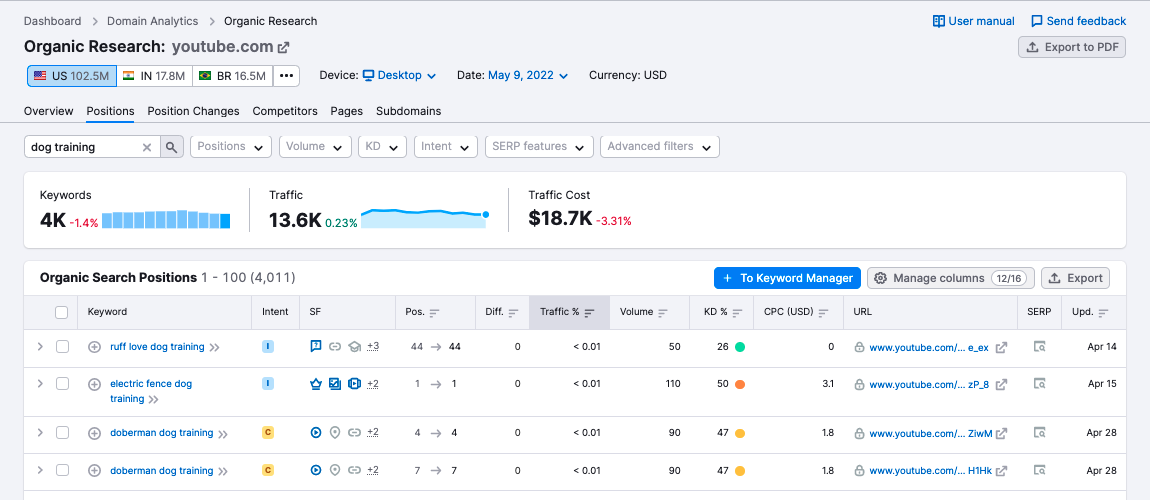
Now you can see keywords where Google likes to show users YouTube videos. Again, you could try this same practice for Reddit, Quora, Yelp, or other forum sites in your niche.
Combining Google Search Console and Semrush to Find New Ideas
Semrush can help you find search queries that have the metrics behind them that you’re looking for (e.g. high search volume, low keyword difficulty score).
However, it won’t be able to tell you which queries your site gets clicks from, and which queries lead to little to no clicks at all. That’s where Google Search Console comes in.
Using Google Search Console to Boost Your Organic Traffic
Google Search Console (GSC) can help you see which terms people have searched and clicked on to find your site. Also, it can tell you terms your site ranks for that have triggered a search result on Google.
Bounce from tab to tab and use GSC directly and still use our free tools. But, with a free trial, you can integrate your Google Workspace with multiple keyword research tools within Semrush to easily find all the data you need.
The SEO Dashboard integrates with both GSC and GA to help you find untapped keywords:
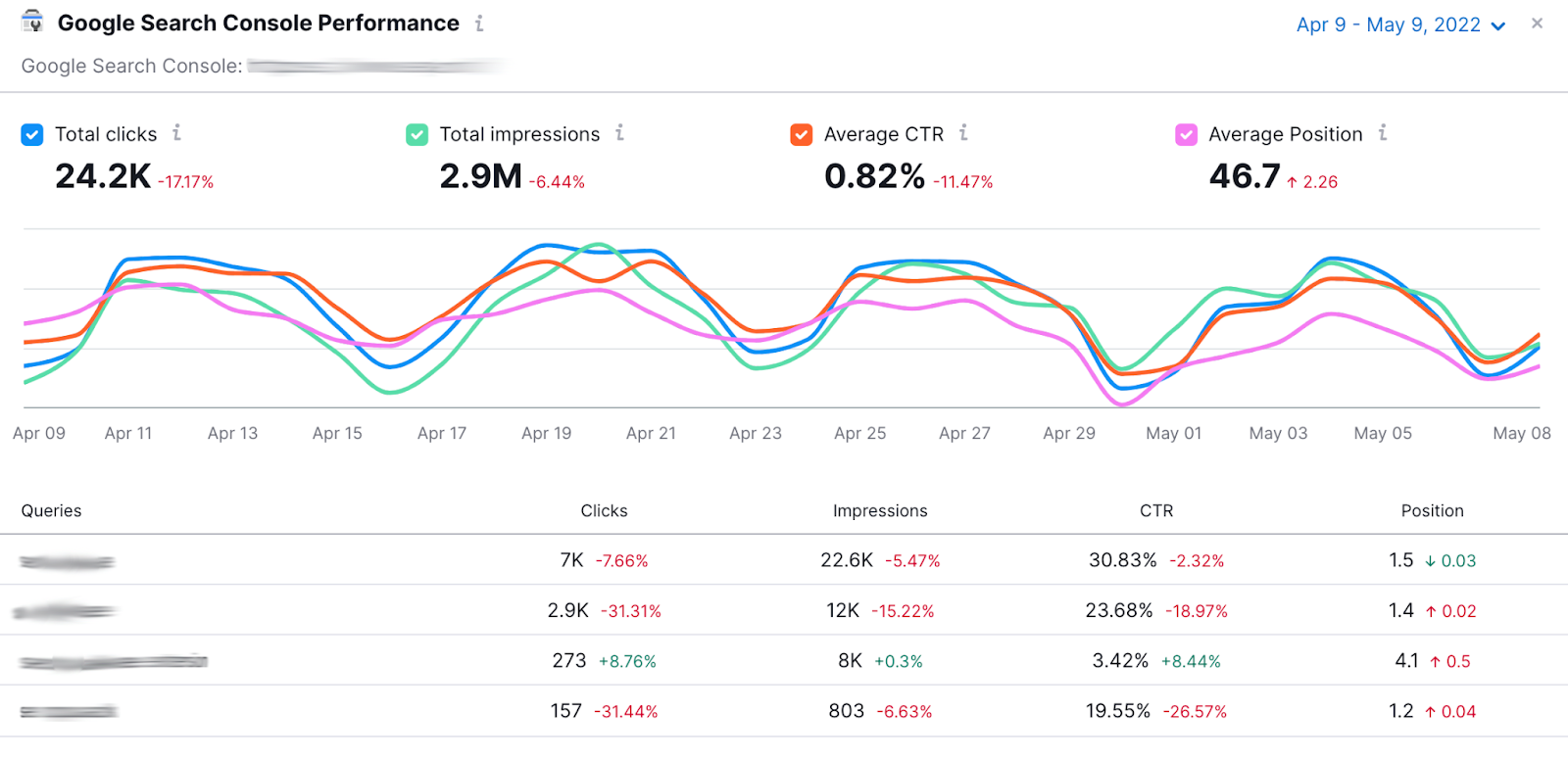
Whichever option you choose, you can sort GSC queries by both clicks and impressions. Level up your keyword research strategy by finding terms that have many impressions, but a low click through rate.
Then, take those keywords to Semrush, where you can implement your site’s GSC data directly into your keyword research strategies. With the Keyword Overview Tool, you can drag and drop a bulk list of GSC queries (100 at a time) to see the metrics behind it.
Just enter a bulk list of up to 100 keywords at a time into the Bulk Analysis tab of Keyword Overview:

For instance, you can find keywords from your GSC that have the right intent behind them. You might be thinking about optimizing a page for a certain query that has tons of impressions, but a low CTR.
The purpose of this page is to encourage readers to purchase a service, but you see the intent is informational through Keyword Overview. Instead, you might opt to optimize for another keyword that matched the intent of that page.
Here you’ll be able to quickly gauge each keyword’s keyword difficulty (KD%) and intent (informational, navigational, commercial, or transactional).
Multiple, reputable data sources shape a reliable plan.
Crafting an Advanced Keyword Strategy with Semrush
There are tons of avenues to explore when working on keyword research. You can use our suite of online visibility tools to discover which keyword research strategies suit you best.
By targeting the right keywords for your niche, going after featured snippets, implementing barnacle SEO, finding high intent keywords, and combining GSC and Semrush, you can take your keyword research to the next level.
Take a dive into the Keyword Magic Tool today and see why millions of marketers consider it to be the best keyword research tool on the market.
